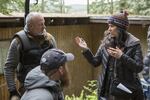
Debra Granik on the set of "Leave No Trace."
Courtesy of Obscured Pictures
Next weekend, BendFilm will offer its first ever Women of the Year prize to New York-based director Debra Granik and her producing partner, Seattle's Anne Rosellini. The festival will also screen the four features they made together. Their critically acclaimed features, including this year's "Leave No Trace" and the Oscar-nominated "Winter's Bone," tease the sublime out of everyday people and places. We spoke with Granik and Rosellini about their projects and process.
Q&A with Debra Granik and Anne Rosellini
April Baer: How did you start working together?
Debra Granik: I always say Anne and I were on the edge of this precipice — the freewill of deciding to make a film just because the two of us say we're going to.
Baer: The first feature you worked on together was [based on Granik’s student film “Snake Feed”] a film the world now knows as “Down to the Bone,” about a working mom who's addicted to drugs. Would you to tell the story of how you got it off the ground?
Granik: We'd shopped it around. The project had been encouraged by the Sundance Lab, some meetings were on our calendar. They were meaningful meetings, but we didn't encounter a production entity that was willing on jump on this. I was feeling pretty defeatist, and Anne says, "Why do we have to wait for permission? No one's going to give it to us. We're going to have to take it and do it ourselves."
Anne Rosellini: Debra had already been going upstate and doing recon to write the script. She had a lot of ideas in mind, so she was already de facto making the film, really. I remember it was the interest of a supportive casting director named Ellen Parks who encouraged us and helped us cast the role which ultimately went to Vera Farmiga. That was the little bit of nudging that we needed to green-light ourselves.
Baer: You two have a process of making films in locations that are really specific to places and the people who inhabit them. Could you explain what you do to find the spirit of each film?
Granik: One of life's pleasures is to go places we haven't been, meet people we didn't previously know, and find out a few things about how they're surviving or how they're thriving.
Rosellini: Usually there's a script and some life models. Those life models usually lead us to locations and to other people that inform the script. Life gets breathed into it through encounters. Small communities aren't afraid to get involved. We've had tremendous luck building those kinds of networks in small communities.
Baer: How do you get people to trust you?
Granik: I'd say it's familiarity and consistency.
Rosellini: You show yourself to be trustworthy overtime. These aren't things that happen after one meeting ever.
Baer: Your second feature, “Winter’s Bone,” was kind of a watershed. It got nominated for four Oscars, including best picture. It was an early big role for Jennifer Lawrence, and it made $16 million. Did you get offers to do studio films?
Granik: We did! We were getting scripts that in the '50s and '60s would have been in that studio column called "The Women's Film." And they are dreary.
Baer: Give us an example. What kind of subjects?
Granik: Psychiatric institutions, hysteria …
Rosellini: Kidnapping. Rape and incest.
Granik: Vomiting a whole lot. Disorders of every kind. Everything that would make you not want to be a female Homo sapien was in that list.
Baer: This year, you released your latest feature, “Leave No Trace.” It's based on the book, “My Abandonment” by Portland’s Pete Rock. It's a story about a military vet and his daughter who are hiding in plain sight, camped in Forest Park for four years. Like a lot of quality adaptations, the film diverges a bit from its source material. What influenced your thinking?
Granik: Our first drafts resembled the novel very closely. And as we worked, we'd throw each other lots of questions. We were very open about this with Pete, so the discussion could be honest. We came up with the question, "What does happen to Caroline/Tom, the daughter?" There was a pivotal discussion over a really long dinner in Portland. I threw out a couple ideas, and Pete said, "You've got to try those. The novel is the embodiment of my imaginings. You two have to at least audition your own imaginings."
